
The Goodwin Sands, located off the Kent coast, represent one of the most perilous and historically significant sandbanks in the UK. This ‘ship swallower’ has claimed more than 2,000 shipwrecks, dozens of World War II aircraft, and countless lives over the centuries, earning its reputation as a treacherous maritime zone. Shakespeare himself once described it as a “very dangerous flat, and fatal.” Today, the sands also hold significant historical and archaeological value, making their preservation a topic of national importance.
An Underwater Time Capsule at Risk
Described as a ‘magical subsea landscape’ by historian and television presenter Dan Snow, the Goodwin Sands are more than just shifting sands; they are a repository of history, with every period over the past 2,000 years leaving its mark. From medieval shipwrecks to remnants of World War II aircraft, these sands offer insights into the UK’s rich maritime heritage. Tragically, their unique legacy is now under threat from potential dredging activities.
Despite being designated a Marine Protected Area (MPA) in 2019, the sands remain vulnerable. Campaigners fear destructive dredging for marine aggregates, used in construction, could jeopardize this vital part of British history. Joanna Thomson, chair of the Goodwin Sands Conservation Trust, warns, “Aircraft could have crew in them, so disturbing final resting places. It’s so hypocritical. Every year we have Remembrance Day at beautiful cemeteries on land, yet dredging here disrupts graves.”
Calls for Royal Intervention
The seabed, owned by the Crown Estate, is at the center of the controversy. Campaigners are urging King Charles to intervene, given his role as a conservationist and beneficiary of the Crown Estate. In a letter to Charles, the Goodwin Sands Conservation Trust emphasized the need to remove the sands from the list of potential marine aggregate extraction sites. While the Crown Estate has stated there are no immediate plans for dredging in the area, it has not ruled out future activities, frustrating conservationists.
Michael Williams, a legal expert on underwater cultural heritage, believes the Crown Estate has the ability—and responsibility—to develop a long-term policy. “You can treat the Goodwin Sands as a highly sensitive archaeological area, declining applications unless under exceptional circumstances. Public bodies adopt similar approaches for culturally sensitive sites on land all the time,” he explains.
A Cultural and Environmental Crisis
The risks of aggregate dredging in this region go beyond its historical implications. As the sands form a natural sea defense, disruption could impact the fragile Kent coastline, which already struggles with erosion. Moreover, ongoing proposals like National Grid’s plan to build an electricity converter station and lay underwater cables near Sandwich Bay have sparked additional concerns. “They need half a million tonnes of sand, and there are fears they will wish to take it from the Goodwins,” says Thomson.
While the Marine Management Organisation (MMO) continues to evaluate these proposals, conservationists insist that protecting the Goodwin Sands aligns with the UK Marine Policy Statement, which highlights the importance of preserving natural and cultural heritage even without specific designations. Wessex Archaeology has identified the Goodwin Sands as holding one of the highest densities of maritime heritage in UK waters, further cementing its value as a site of national interest.
How You Can Support the Cause
Protecting this unique cultural treasure requires public awareness and action. Purchase ethical, environmentally friendly building materials to reduce the demand for marine aggregates that endanger protected areas. For example, brands like Eco Building Products offer sustainable alternatives.
Additionally, you can support campaigns like the Goodwin Sands Conservation Trust’s efforts to halt dredging. Staying informed about developments and supporting initiatives that promote heritage conservation can make a lasting impact.
A Legacy Worth Preserving
The Goodwin Sands are more than just a maritime anomaly—they are a tribute to the UK’s collective history. From ancient shipwrecks to wartime relics, every grain of sand holds a story. Ensuring that this unique marine environment is protected for future generations is not just a noble cause; it is a responsibility. Join the movement to defend one of Britain’s most irreplaceable underwater treasures.



